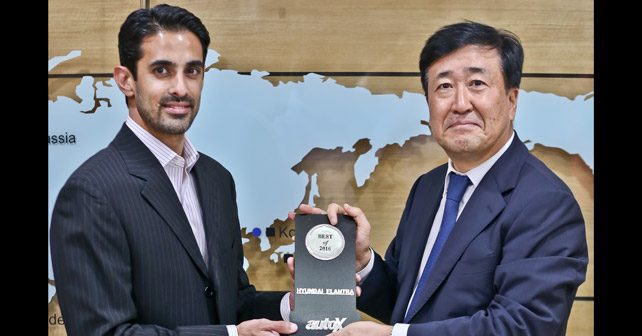
Hyundai Elantra
You’ve launched the Elantra in a segment that has not been very positive of late. How has the customer response been?
YKK: Till the close of October, from the launch, we had already received over 1,500 bookings for the new Elantra – which translates to a waiting period of almost four to five months. When we launched the Elantra, we announced that our plan was to sell between 300-350 units a month, and our target volume for 2016 was 1,400 units. So, with bookings already exceeding our target, we’re very happy with the success of the Elantra and the overall market sentiment. With the Elantra’s segment only clocking 1,000 units per month, this is a significant achievement and we think we can create substantial numbers in this segment with a class-leading product.
What is your expectation for the Tucson?
YKK: Actually, we had to postpone the launch of the Tucson because our factory in Busan, Korea, faced heavy flooding last month. And since we’re launching it quite late in the year, we don’t expect very large volume from the Tucson this year. But, more importantly, with the Tucson’s launch, we’re fulfilling our promise to the Indian customer that we’ll launch two new models every year.
Your Chennai plant has been running at almost 100% capacity for quite some time, what’s the solution to increasing production?
YKK: For now, we have enough production capacity – as we can stretch to around seven lakh units in the current factory. And if domestic volumes keep increasing like they are, we can even look at reducing the volume of exports from the factory and concentrate on the domestic market. So we are open to adjusting our production volume and are flexible about juggling between the domestic market and exports. There have been questions about increasing space at the current plant or a new factory, but at the moment we’re quite happy with our flexibility and the production capacity.
What are your expectations with GST coming in?
YKK: The current government, to give them credit where its due, is very aggressive on economic matters and it’ll be interesting to see if GST comes in at its slated date of 1st April, 2017. There are lots of the benefits for the automotive industry. With India’s 29 states levelling different taxes, it becomes a challenge for any automaker to operate in India – and GST will not only ease this process, but it’ll also help in the country’s branding in regards to how business oriented the economy and the taxation system is.
RS: We believe that the Government will announce GST with the next budget. The biggest thing we’re looking forward to is that it’ll bring a lot of benefits to the industry. One is logistics, because today when our products have to move from Chennai to Delhi, they cross almost eight states. Now, tackling the state barriers of all those states is pretty cumbersome and time consuming, but with the uniformity of GST the vehicle will just keep moving straight through – which will reduce the time taken in logistics, and the hassle of additional paperwork. That is where the biggest benefit for the industry will come in. Secondly, currently the market for spare parts is divided into two – the wholesale market and the retail market. With the introduction of a single tax structure, there will be uniformity and India will become a true retail market – and that has the potential to further spur sales in India, especially in the rural areas of country where supplies will be easier to provide thanks to the ease of movement and taxation. You have to keep in mind that the auto industry faces the highest amount of taxation in India after tobacco. And the forms of taxation are quite different, ranging from Customs, Excise, Sales Tax, Local Body taxes, etc. When you look at how many structural taxes there are, plus the registration taxes – so all these taxes merging together will be one of the biggest benefits for the auto industry, and will bring in some much needed transparency.
Will meeting the Euro VI emission norms and the new crash safety guidelines be a challenge for you?
YKK: No, for us it is not a challenge. In fact, we’re quite ready for it. But, the cost increment of meeting these new standards on both the emissions and the safety front needs to be borne by someone. And that will be a tricky one to decide, in terms of who will bear the cost of these changes. We will, of course, bear some part of it – but some of it will have to be passed to the customer. So we’re quite ready to introduce Euro VI engines and meet the new safety standards, there are no issues from our end.
With Kia planning to enter the Indian market, will there be any changes to your sales approach? And are there any chances of a collaboration considering they’re a sister brand?
YKK: Kia is a completely separate organisation. Our managements are different, and our operations are also independent of each other. The only thing we share is the same Chairman. They are our sister company, but we’re not partners. In most markets, we’re competitors working independently to increase market share and sell more products. Now, India is not an easy market. Out of the fifteen automotive manufacturers present in India – except the premium brands – how many have been successful? The European and Japanese brands, they are all here, but its only brands like Hyundai, Maruti and now Mahindra & Mahindra, to some extent, that have done well in the Indian market. If you look at the sales numbers, most other brands have not been able to achieve the same level of success that we’ve been able to achieve in the last 18 years. We entered the Indian market at the same time as most other brands – barring Maruti, of course – but the result has been different. We started with the target of selling 7,000 to 10,000 Santro’s per month in India, and that is important because to achieve that large a volume we needed the required sales points, the infrastructure, the manpower and the capacity. We built on that from day one, whereas some brands were happy selling just 1,000-2,000 units. We needed the marketing strategy for 7,000 sales, because selling just 1,000 units is much easier – you require a smaller network and presence on the ground. But to meet our target was very tough and we had to build our network, strategy, production numbers and profitability to be successful, and that’s what we built on. So, where you start in India and what your long-term targets are is a very important aspect for success in a difficult market like India.
























Write your Comment